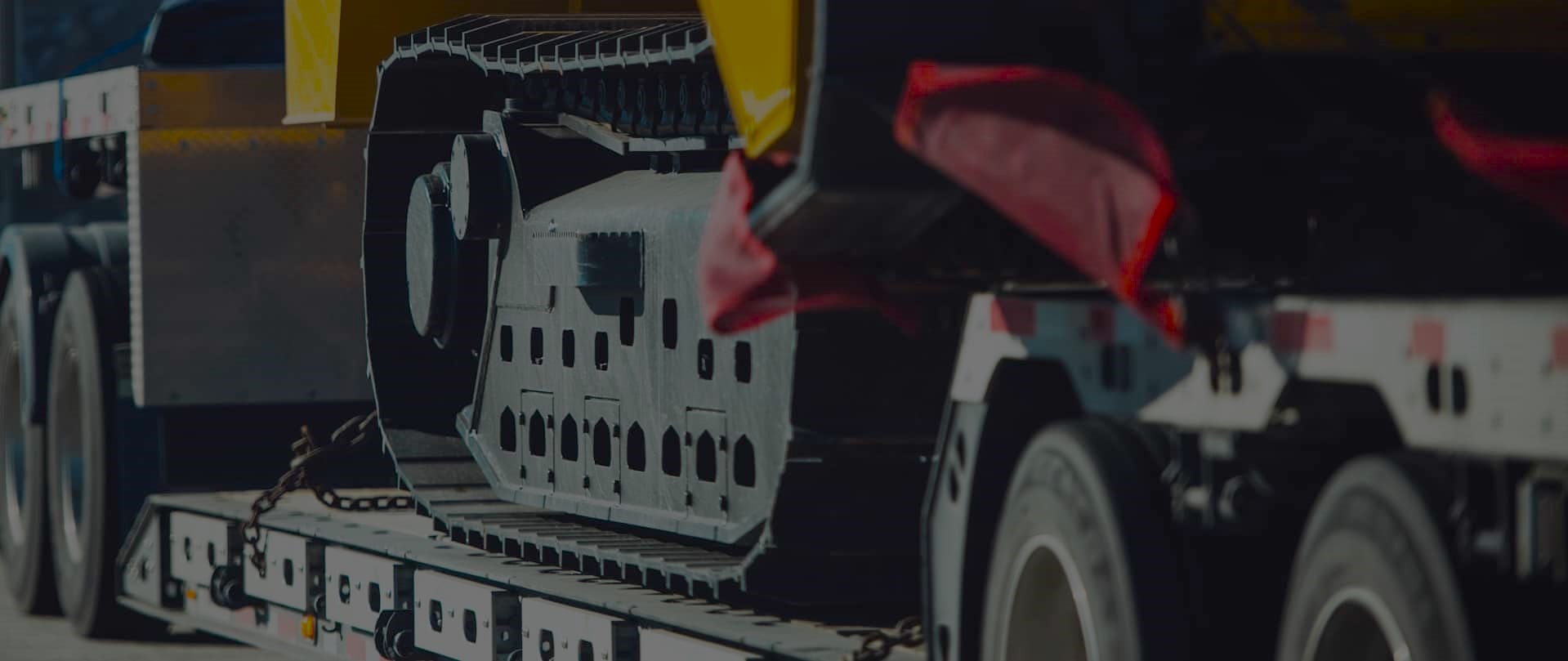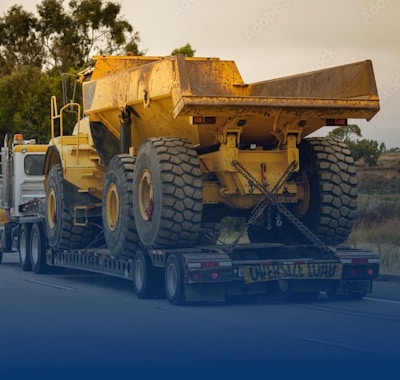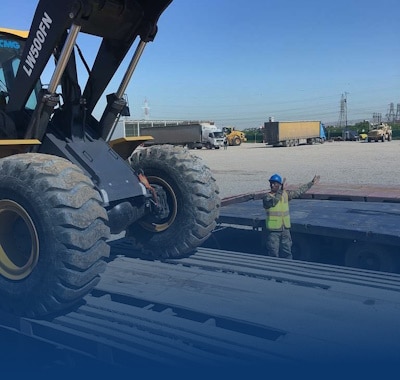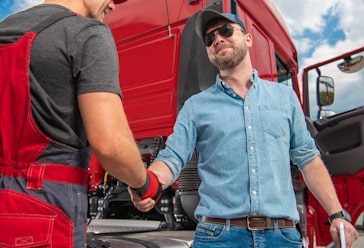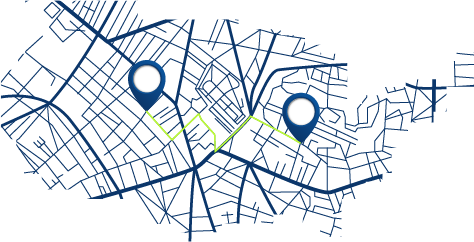Key Oversize Planning Tips for Crossing the Mississippi River
Freedom Heavy Haul can offer expedited Pickup and Delivery for any size shipment anywhere in the USA. Contact us today for No Hassle, No Pressure Pricing.
This guide blends roadway permit rules, route engineering, and on-water operations to help movers avoid delays and extra costs. State OSOW rules differ, so you must secure permits and plan routing for each jurisdiction before departure.
Measure carefully: load height is taken from ground to tallest point, including trailer and tires. Trailer decks vary — flatbed, step-deck, double-drop and perimeter heights matter when you count total feet. A few inches can decide whether you clear a bridge.
Use Army Corps navigation maps and mile markers to plot locks and buoys. The Upper Mississippi has 27 locks; the Lower is wider, faster, and has heavy barge traffic. Barges need long stopping distances and VHF radio helps coordinate with lock operators.
Expect this guide to show state-by-state height realities, measurement checks, routing along way, and practical steps around bridges, power lines, and locks. It also covers when to call heavy-haul services and how season, wind, and water shape daily timing.
Who this how-to guide is for and how to use it today
This guide helps shippers, logistics managers, project cargo teams, and owner-operators who move large loads near a major river. Use it to confirm dimensions, assign roles, and build a compliant route before departure.
Start simple: first verify height and width, then pick the right trailer and map a path across each state line. Next, load charts, mile markers, and permit contacts so your team shares one set of facts.
- Confirm load dimensions and permits.
- Select equipment and set responsibilities.
- Plot a route that ties Army Corps charts to GPS.
- Prep communications, alternates, and access to maps.
Bring a shared bag of documents (permits, maps, emergency contacts). Keep digital copies synced so any team member can pull information on the day of transit.
“Treat this as a living playbook you can open at any time to verify miles, timing windows, and services in nearby towns.”
Outcome: clear steps, plain-English data, and a repeatable way to reduce delays and surprises.
Understand oversize and overheight rules on both sides of the river
Height limits vary across states, which can stop a move in its tracks if you assume uniform rules. West of the river most jurisdictions allow taller legal heights—many accept 14 feet, and Colorado and Nebraska permit 14 ft 6 in. East of the river, most states set 13 ft 6 in, with a few exceptions such as Maine at 14 ft.
Always measure from ground to the highest point, including trailer decks and tires. An extra inch can force a detour or a permit revision.
Why limits differ and what that means
Differences come from older eastern bridges, dense metro areas, and historic standards that simplify multi-state travel. Translate that into routing by noting where a taller-legal west bank meets tighter eastern clearances.
- Compare feet by state so a 14-ft route does not hit a 13 ft 6 in restriction.
- Mark the miles where state lines occur and recheck limits before you cross.
- Plan alternates and record critical information in your permit packet for quick use.
“Measure to the highest point and carry state clearance data — it prevents inch-based surprises near bridges.”
For river corridors, flag when you move between the Upper Mississippi River and the Lower Mississippi River. Flow, traffic and area constraints can change rapidly near locks and boat channels, so build concise navigation notes into your route file.
Key oversize planning tips for crossing the Mississippi River
Start every move by measuring the loaded height on level ground—don’t trust specs alone. Freight height is taken from the ground to the tallest point, including trailer decks and tires. Record that number in feet and re-check after securement to catch any suspension or stack shifts.
Make sure you map each jurisdiction along your route and pre-clear permits at the state, county, and township levels. Permit delays are common; file early and attach photos and measured dimensions to speed approvals.
Engineer the path around fixed structures
Bridges, power lines, and lock approaches cannot be moved. Use route engineers to pick secondary roads when needed. Include bridge spans, overhead utilities, railroad crossings, and river-adjacent constraints on your maps.
- Measure in feet on level ground and log verification times.
- Switch to a lower-deck trailer when you’re within an inch or two of a critical clearance.
- Track water level advisories and work-zone notices that affect overhead profiles.
“If you plan the way, you reduce downtime and avoid damage.”
| Issue | Action | Typical impact | Timing |
|---|---|---|---|
| Height uncertainty | Physical tape measure on level ground | Prevents bridge strikes | Before departure |
| Permit gaps | Map states, counties, townships; pre-clear | Avoid stop-and-wait delays | Days to weeks ahead |
| Fixed obstacles | Route engineer selects alternate way | Safer turns, legal clearance | Planning stage |
| Water level changes | Monitor advisories and update maps | Approach clearance shifts | Check daily |
Permits, escorts, and when to specify heavy haul instead
Start by confirming which jurisdictions require separate permits and what each permit allows on roads near major waterways. Over-dimensional freight needs a permit from every state, county, and township on your route. Many agencies will deny overheight on a flatbed if a lower-deck trailer is available.
Know the triggers for escorts. Pilot cars are often tied to width, length, and loaded height in feet. Some corridors add curfew windows that limit moves during high-traffic times. Lock and dam districts concentrate infrastructure and traffic; plan escorts and staging there.
- File permits at state and local levels to avoid downtime at borders.
- When height approaches 17 feet, specify heavy haul service: expect higher cost, stricter routing, and more approvals.
- Coordinate timing where barges, terminals, and river activity increase congestion.
| Issue | Mitigation | Typical impact | When |
|---|---|---|---|
| Missing local permit | File county/town permit | Stops at checkpoints | Days before move |
| Escort trigger | Book pilot or police escort | Safer transit through tight corridors | At permit stage |
| Loaded height >17 feet | Engage heavy haul service | Higher cost per mile, strict routing | Planning and permit filing |
| River-area congestion | Stagger start times | Less delay near locks | Adjust departure times |
“Document permitted dimensions on cab papers and brief drivers on the approved path and times.”
Choose the right trailer to reduce loaded height and cost per mile
Match freight to equipment early. Start with exact dimensions so deck height keeps total clearance below the lowest known limit on your route. Small deck differences add up in feet.
Deck-height references: flatbed ~5 ft (works up to 8 ft 6 in freight), step-deck ~3 ft 6 in, double-drop/lowboy ~24 in, RGN ~24 in, perimeter ~18 in. Use a lower-deck option when a few inches save a long detour.
Flatbed vs. step-deck vs. lowboy, RGN and perimeter
- Confirm whether freight is divisible. Stacked units often must be split and cannot move as over-dimension loads—this changes miles and load plans.
- Ask carriers for specs and photos so you have clear information on deck height, winch points, and tie-downs.
- Perimeter and RGN equipment reduce height but carry higher cost per mile and may trigger escorts; book them early in busy states.
- Align trailer choice with bridge approach grades and turning radii near riverfront infrastructure to avoid ground-clearance issues.
“The right trailer often pays for itself by shortening the route and avoiding permit headaches.”
| Trailer | Typical deck height | Use case |
|---|---|---|
| Flatbed | ~5 ft | Up to 8 ft 6 in freight; lowest cost per mile |
| Step-deck / Lowboy / RGN | ~24–3 ft 6 in | Tighter clearances, river corridor approaches |
| Perimeter | ~18 in | Very tall/wide units; heavy haul specialty |
Final note: balance per-mile service cost against longer detours. Check securement compatibility with boats or boat-like loads to prevent damage during transport near waterfronts.
Locks, dams, and traffic: operating safely around high-traffic points
Locks and dams concentrate river traffic and require clear communication, staging, and simple checklists to move people and gear safely. Treat these spots as controlled intersections: noise, wakes, and vessels of all sizes converge and timing matters.
Carry a VHF/marine radio and call ahead to lock operators for queue status, expected time, and any temporary closures. Army Corps charts show exact mile markers so you can confirm approach geometry before you arrive.
Using marine radio to coordinate with lock staff
Make a radio call with your name, location, and request. Ask about closures and expected wait time so you can stage or move to a nearby marina if needed.
Lock etiquette, arrival times, and closures
Arrive early, stage safely, and keep lines, fenders, and roles ready. Prioritize inside bends to avoid barge tracks; outside corners carry heavier wakes and faster flows.
- Remember a barge can take roughly a mile to stop—never rely on last-minute maneuvers.
- Secure loose gear; reflected waves and wake can rebound off lock walls.
- Check water level advisories and scheduled maintenance and pad your schedule to absorb short delays.
- Use nearby marinas for fuel, water, and quick resupply to avoid stacking delays during peak traffic.
“Radio early, arrive staged, and run a short checklist: radio call, lines ready, fenders set, and roles assigned.”
Route engineering with Army Corps maps, mile markers, and GPS
Pull the correct Army Corps charts and mark mile handoffs before you drive to the waterfront. That single step avoids mixing Upper and Lower map sets and prevents wrong-mile routing near locks.
Upper vs. Lower map sets and reading mile systems
The Upper map set runs from just north of Minneapolis (mile 865) down to the Ohio confluence (mile 0) and includes 27 locks. The Lower set begins at the Ohio confluence (mile 953 in its scheme) and continues to the Gulf.
Mark the handoff mile precisely so your navigation reflects the correct chart and lock numbering as you change segments.
Inside bends, buoy colors, and staying in the navigation channel
Stay in the channel for depth and clear right-of-way. Downstream, pass right of red buoys and left of green; red buoys have coned tops and green have flat tops.
Favor inside bends to avoid faster outside-corner flow and heavy barge traffic. That reduces wake exposure and makes approaches to bridges and locks safer.
Overlay satellite and offline GPS for complex islands and sloughs
Overlay recent satellite tiles to spot island clusters, sandbars, and alternate channels. Preload offline GPS (examples: OsmAnd, cached Google satellite) so your plan works without cell signal.
Use location notes on charts for bridges, low-clearance points, and towns with fuel or services, and assign a navigator to call out upcoming mile markers and buoy changes.
- Pull the correct map set and note differing mile systems.
- Build your route around mile markers and nearby towns with service options.
- Synchronize digital charts and carry printed map sections as redundancy.
“Mark handoffs by mile, stay in the channel, and pair satellite overlays with offline GPS to navigate complex sections.”
| Map set | Range (mile) | Notes | Action |
|---|---|---|---|
| Upper Corps | ~865 → 0 | Includes 27 locks; tighter inland bends | Use lock charts and log miles |
| Lower Corps | ~953 → 0 (downstream) | Faster flow and heavier barge traffic | Favor channel centerline and note buoys |
| Satellite overlay | Varies | Shows islands, sloughs, sandbars | Preload tiles and mark alternates |
| Offline GPS | All segments | Works without cell signal | Sync charts and print critical pages |
Seasonality, water levels, wind, and daily mile targets
Seasonal windows and weather set realistic daily goals. In Minnesota the season usually opens in April–May and winds down in late September to early October. Early runs can see higher flow; late season often brings low water and portage challenges across lakes.
Upper Mississippi segments include portages, large lakes, and frequent locks. Expect slower progress—about 30 miles per day with roughly 1 mph net flow. Budget extra time for lake crossings when winds create strong waves and longer waits at 27 locks between Minneapolis and north of St. Louis.
Lower Mississippi offers faster flow and higher daily progress—typically near 50 miles per day with 3–5 mph currents. That speed brings more barge traffic and bigger wakes, so keep tight situational awareness.
- Plan conservatively and adjust each morning using flow and wind forecasts.
- Stand down if sustained winds exceed 15 mph as a head or cross wind.
- Track level advisories and mark problem areas where shoaling slows your line.
“Update your operations log by mile and keep a pivot plan for each segment.”
Pack a small bag with foul-weather gear, spare tie-downs, and basic repair items. Review actual times and miles daily to refine ETAs and avoid surprises.
| Zone | Avg miles/day | Notes |
|---|---|---|
| Upper | ~30 | Portages, lakes, 27 locks |
| Lower | ~50 | Faster flow, more wakes |
| Weather | Varies | Winds >15 mph may halt movement |
Sharing the river with barges, boats, and wakes
Give commercial tows a wide berth: their stopping distance can approach a full mile. Treat large pushes as constrained vessels with priority and plan movements well in advance.
After Minneapolis, follow red/green buoys and stay inside bends where possible. That reduces exposure to heavy lanes and the strongest flow river currents near outside corners.
It can take a barge about one mile to stop—give them the right of way
Plan crossings and holds well before you reach a tow. Log encounters by mile and note conditions so crews learn recurring patterns.
Crossing the channel, wake angles, and avoiding tug stern waves
When you must cross, wait for a clear gap, set a decisive angle, and move briskly. Never linger in front of tug traffic and avoid passing directly behind a tug; stern wakes create standing waves that persist.
Wing dams, sandbars, and avoiding hazardous currents
Wing dams guide flow and change with seasons: they are often submerged on the Upper and exposed on the Lower. Steer wide to avoid eddies, shoals and unexpected sand features.
- Treat barges as constrained and keep distance.
- Cross decisively; don’t drift in the channel.
- Turn into waves at a safe angle on the Lower, where wakes and flow interact.
- Keep boats spaced and use clear signals near river structures.
| Hazard | Action | Impact |
|---|---|---|
| Large tow | Yield and wait | Prevents close calls; long stop distance (~1 mile) |
| Stern wake | Avoid crossing behind tug | Reduces risk from standing waves |
| Wing dams / shoals | Steer wide; read buoys | Avoid grounding and hazardous currents |
“Log barge encounters by mile and conditions so future runs can anticipate similar traffic patterns.”
Staging, services, and resupply along the way
Marinas and yacht clubs often act as the best resupply hubs—they usually charge per-foot and offer showers, laundry, fuel, and water. Call ahead to confirm hours and potable-water availability; some supplies sit a mile or two from the dock.
Marinas and yacht clubs: showers, laundry, fuel, and water
Use marina stops to top off water and fuel and to rest crews. Many facilities will pump potable water and sell fuel. Bring a small bag to carry groceries and parts between dock and town. Gas cans (5 gal) can weigh nearly 50 lb, so use two-person carries or a sturdy pack.
Strategic towns, service distances, and planning zero days
Research towns by location and distance from your mooring. Plan zero days in area hubs with multiple services to handle maintenance and shopping. Ask locals for the best stores and rides—residents often point to reliable transport or shortcuts.
- Stage near marinas to access showers and potable water.
- Pack a durable bag or two; plan safe carries for heavy fuel cans.
- On the Upper, use sloughs and side channels for quiet staging; on the Lower, favor sandbar back sides when safe.
- Secure boats with two tie points; currents and changing times can tug gear loose.
“Top off water and confirm services before you arrive—one missed shop can cost a day.”
| Service | Typical source | Distance from dock | When to plan |
|---|---|---|---|
| Showers & laundry | Marina / yacht club | Dockside | Every few days |
| Fuel & potable water | Marina fuel dock | Dockside to 0.5 mi | Top off at each stop |
| Groceries & parts | Town store / hardware | 0.5–2.0 mi | Plan zero day or quick runs |
| Quiet staging | Sloughs / sandbar backs | Nearby channel | Overnight or rest day |
Your pre-move checklist to avoid surprises on crossing day
Prepare the essentials early. A tight morning schedule makes mistakes more likely. Confirm dimensions, permits, and contact info the day before and stage close to your first constraint to reduce last-minute scrambling.
Dimensions verified, permits in-hand, route and alternates loaded
Measure from ground to the highest point on level ground and record feet and inches after securement. Attach photos and a signed log to your move packet so inspectors and people on your team see verified data fast.
Store OSOW permits for each involved state, county, and township as PDFs and hard copies. Load primary and alternate route files and printed maps into the cab GPS and hand charts. If clearance is within inches, consider lower-deck equipment rather than relying on field tweaks.
Contact list: DOTs, lockmasters, utilities, and emergency services
Build a concise contact sheet: state DOT permit offices, local utility lift crews, nearest lockmasters (include lock and lock dam IDs), emergency services, and roadside support. Pre-program VHF/marine channels and test radios and backups before departure.
- Assign roles for escort coordination, pilot vehicles, and documentation.
- Check water level and construction advisories on the morning of movement and log any plan changes.
- Stage a day early when possible and pack a go-bag with PPE, printed permits, tie-downs, flashlights, spare batteries, and hydration.
“Measure, document, and assign roles — small steps that prevent big delays.”
| Item | Action | When |
|---|---|---|
| Dimensions | Measure on level ground; photo + signed log | Before departure |
| Permits | Collect PDFs & hard copies for every state/county/township | Days ahead |
| Routes & maps | Load primary and alternates to GPS; print key pages | Night before / morning |
| Contacts | Pre-program DOT, lockmaster, utility, emergency numbers | Before staging |
| Go-bag | PPE, tie-downs, fuses, lights, water | Packed day before |
Ready to roll: navigate America’s biggest river corridor with confidence
Ready to roll, celebrate each completed segment and run a short debrief with your crew to capture what worked and what to change.
Keep Army Corps charts and VHF channels handy and favor inside bends on approaches. From the Upper Mississippi with its 27 locks through St. Louis and down the Lower Mississippi toward New Orleans, expect different flow and traffic rhythms.
Give barges space—a commercial tow can take about a mile to stop. Verify measured clearances in feet, pick the right trailer, and use marinas in towns for service and rest.
Pack your go-bag, keep permits and contact numbers where people can reach them, and repeat water, weather, and traffic checks. With permits, maps, and good communication, you’re set to move safely and on time.
